| کد مقاله | کد نشریه | سال انتشار | مقاله انگلیسی | نسخه تمام متن |
|---|---|---|---|---|
| 2948898 | 1577254 | 2011 | 8 صفحه PDF | دانلود رایگان |

ObjectivesThis study sought to compare clinical, echocardiographic, and cardiopulmonary exercise testing response to cardiac resynchronization therapy (CRT) in patients with unfavorable anatomy of coronary sinus (CS) veins, randomized to transvenous versus surgical left ventricular (LV) lead implantation.BackgroundCRT efficacy depends on proper positioning of the LV lead over the posterolateral wall. A detailed pre-operative knowledge of CS anatomy might be of pivotal importance to accomplish a proper LV lead placement over this area.MethodsStudy population included 40 patients (age 66 ± 4 years) with heart failure and indication to CRT, with unsuitable CS branches anatomy documented by pre-operative multislice computed cardiac tomography; 20 patients (Group 1) underwent surgical minithoracotomic LV lead implantation whereas 20 (Group 2) were implanted transvenously. New York Heart Association functional class, echocardiographic, and cardiopulmonary exercise testing data were assessed before and 1 year after CRT-system implant.ResultsIn all Group 1 patients, the LV leads were placed over the middle-basal segments of the posterolateral wall of the LV. This was not possible in Group 2 patients. One year after CRT, in Group 1, a significant improvement of New York Heart Association functional class, LV ejection fraction (from 28.8 ± 9.2% to 33.9 ± 7.2%, p < 0.01), LV end-systolic volume (from 165 ± 53 ml to 134 ± 48 ml, p < 0.001), and peak Vo2/kg (from 10.4 ± 4.5 ml/kg/min to 13.1 ± 3.1 ml/kg/min, p < 0.02) was observed. However, no improvement was observed in Group 2: LV ejection fraction varied from 27.4 ± 4.8% to 27.4 ± 5.7% (p = 0.9), LV end-systolic volume from 175 ± 46 ml to 166 ± 44 ml (p = 0.15), and peak Vo2/kg from 11.2 ± 3.2 ml/kg/min to 11.3 ± 3.4 ml/kg/min (p = 0.9). Changes after CRT between groups were highly significant.ConclusionsIn the setting of unfavorable CS branches of anatomy, CRT by a surgical minithoracotomic approach is preferable to transvenous lead implantation.
Journal: Journal of the American College of Cardiology - Volume 58, Issue 5, 26 July 2011, Pages 483–490